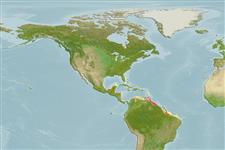Klassifizierung / Names
Namen | Synonyme | Catalog of Fishes(Gattung, Arten) | ITIS | CoL | WoRMS | Cloffa
>
Ophidiiformes (Cusk eels) >
Ophidiidae (Cusk-eels) > Ophidiinae
Etymology: Ophidion: Diminutive of Greek, ophis = serpent (Ref. 45335); guianense: Named for Guiana, NE South America, preseumed center of its distribution..
More on authors: Lea & Robins.
Environment: milieu / climate zone / depth range / distribution range
Ökologie
seewasser benthopelagisch; tiefenbereich 18 - 61 m (Ref. 81834). Tropical
Western Atlantic: Saba Bank (eastern Caribbean Sea) to Venezuela and Suriname, 18-61 m. Probably widespread along the Guianan coast and westward in the southern Caribbean Sea.
Size / Gewicht / Alter
Maturity: Lm ? range ? - ? cm
Max length : 11.7 cm SL (female)
Kurzbeschreibung
Morphologie | Morphometrie
Rückenflossenweichstrahlen (insgesamt): 109-122; Afterflossenweichstrahlen: 91 - 96; Wirbelzahl: 63 - 66. This species is diagnosed by the following characters: D 109- 122 (usually 112-117); A 91-96 (usually 94 or 95), pectoral-fin rays 19 or 20 (modally 19); vertebrae, precaudal 15-16, caudal 47-50 (usually 48-50), total 63-66 (usually 64-65); lower arm of first gill arch with 5-6 developed rakers; short head, inferior mouth but not distinctly overhung by snout; dorsal and ventral profiles of body nearly parallel for much of its length; unmarked body; pelvic rays intermediate in length, reaching under middle of opercle (Ref. 81834).
Life cycle and mating behavior
Geschlechtsreife | Fortpflanzung | Ablaichen | Eier | Fecundity | Larven
Lea, R.N. and C.R. Robins, 2003. Four new species of the genus Ophidion (Pisces: Ophidiidae) from the western Atlantic Ocean. University of Kansas Museum of Natural History, Scientific Papers No. 31:1-9. (Ref. 81834)
IUCN Rote Liste Status (Ref. 130435)
Bedrohung für Menschen
Harmless
Nutzung durch Menschen
Mehr Information
NamenSynonymeMetabolismusRäuberÖkotoxikologieFortpflanzungGeschlechtsreifeAblaichenSpawning aggregationFecundityEierEientwicklung
Alter/GrößeWachstumLänge-GewichtLänge-LängeLängenhäufigkeitenMorphometrieMorphologieLarvenLarven Pop.Dyn.RekrutierungDichteBRUVS
ReferenzenAquakulturAquakultur ProfilZuchtlinienGenetikElectrophoresesVererbbarkeitKrankheitenVerarbeitungNutrientsMass conversion
PartnerBilderStamps, Coins Misc.LauteCiguateraGeschwindigkeitSchwimmstilKiemenoberflächeOtolithsGehirngrößeSehfähigkeit
Tools
Zusatzinformationen
Download XML
Internet Quellen
Estimates based on models
Preferred temperature (Ref.
123201): 26.4 - 27.6, mean 27.2 °C (based on 17 cells).
Phylogenetic diversity index (Ref.
82804): PD
50 = 0.5000 [Uniqueness, from 0.5 = low to 2.0 = high].
Bayesian length-weight: a=0.00102 (0.00046 - 0.00225), b=3.06 (2.88 - 3.24), in cm total length, based on all LWR estimates for this body shape (Ref.
93245).
Trophic level (Ref.
69278): 3.4 ±0.6 se; based on size and trophs of closest relatives
Widerstandsfähigkeit (Ref.
120179): hoch, Verdopplung der Population dauert weniger als 15 Monate. (Preliminary K or Fecundity.).
Fishing Vulnerability (Ref.
59153): Low vulnerability (10 of 100).
